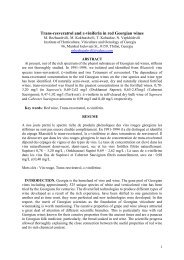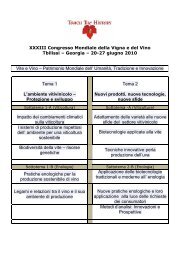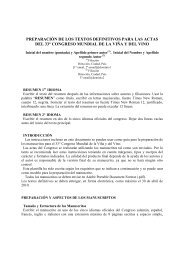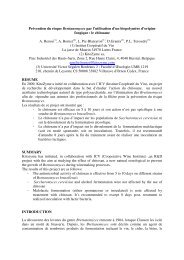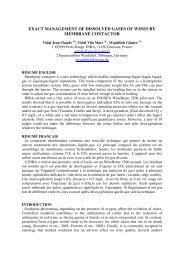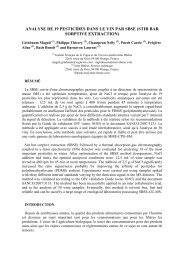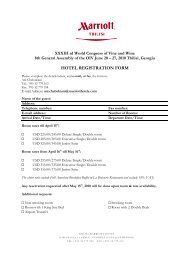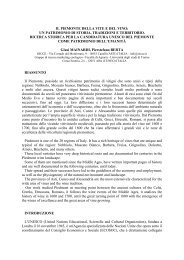Characterization of Georgian white grape wines made ... - Oiv2010.ge
Characterization of Georgian white grape wines made ... - Oiv2010.ge
Characterization of Georgian white grape wines made ... - Oiv2010.ge
Create successful ePaper yourself
Turn your PDF publications into a flip-book with our unique Google optimized e-Paper software.
Kakhuri Mtsvane and both Rkatsiteli from Kardenakhi <strong>wines</strong> (with and without stem contact),<br />
which, in turn, are different from another region Rkatsiteli (Kardenakhi) wine.<br />
Compounds<br />
Table 4 Varietal compounds in amphorae <strong>wines</strong> (µgL -1 )<br />
Kakhuri<br />
Mtsvane<br />
Rkatsiteli<br />
Kardenakhi<br />
Rkatsiteli<br />
Gurjaani<br />
Rkatsiteli<br />
Kardenakhi with<br />
stems<br />
trans-furan linalool oxide 9,3 6,1 7,8 6,5<br />
cis-furan linalool oxide 19,9 11,9 13,8 11,3<br />
linalool 25,8 12,6 4,3 12,1<br />
α-terpineol 11,2 6,0 6,6 5,7<br />
trans-pyran linalool oxide 9,8 4,1 6,7 4,7<br />
nerol 6,9 15,8 14,3 19,3<br />
geraniol 30,9 48,3 35,5 61,0<br />
trans-8-OH-linalool 54,4 40,8 33,0 53,0<br />
cis-8-OH-linalool 65,8 116,4 36,2 44,4<br />
trans/cis furan linalool oxide 0,5 0,5 0,6 0,6<br />
trans/cis pyran linalool oxide 0,9 0,7 0,8 0,9<br />
trans/cis 8-OH-linalool 0,8 0,4 0,9 1,2<br />
linalool/geraniol 0,8 0,3 0,1 0,2<br />
nerol/geraniol 0,2 0,3 0,4 0,3<br />
linalool/nerol 3,7 0,8 0,3 0,6<br />
[linalool+nerol+geraniol]/ α –<br />
terpineol<br />
5,7 12,8 8,2 16,2<br />
Conclusion<br />
Wines in earthwork amphorae were vinified using ancient, traditional method <strong>of</strong><br />
winemaking, which can be fined as good quality wine in regards <strong>of</strong> all standards. Were<br />
studied their polyphenolic and volatile composition. Main differences were notified among<br />
<strong>wines</strong> <strong>made</strong> with and without stem contact. It was distinguished that stem contact wine<br />
consists less quantities <strong>of</strong> various polyphenols and more – n-hexanol and isoamyl alcohol.<br />
About varietal content can be said that by using this technology no difference was found<br />
among <strong>wines</strong>.<br />
References<br />
1. ARNOLD R.M., NOBLE A.C. (1978). Bitterness and astringency <strong>of</strong> <strong>grape</strong> seed phenolics<br />
in a model wine solution. Am. J. Enol. Vitic., (29): 150-152.<br />
2. ARNOLD R.M., NOBLE A.C., SINGLETON V.L. (1980). Bitternes and astringency <strong>of</strong><br />
phenolic fractions in wine.J. Agric. Food Chem., (28): 675-678.<br />
3. BAUMES R., CORDONNIER R., NITZ S., DRAWERT F. (1986). Identificationand<br />
determination <strong>of</strong> volatile constituents in <strong>wines</strong> from different vine cultivars. Journal <strong>of</strong> the<br />
Science Food and Agriculture, (37): 927–943.<br />
4. BAYONOVE C., BAUMES R., CROUZET J., GUNATA Z., (1998). Œnologie:<br />
Fondements Scientifiques et Technologiques. FLANZY C. (Ed.), Lavoisier, Paris, France.<br />
5. BERIDZE G.I. (1965). <strong>Georgian</strong> <strong>wines</strong> and brendies (Вина и коньяки Грузии), Tbilisi.<br />
6. BOURZEIX M, WEYLAND D, HERADIA N. (1986). Etude des catechines et des<br />
procyanidols de la grappe de raisin, du vin et d’autres derives de la vigne. Bull OIV,<br />
(59):1171- 1254.<br />
7. COCITO C., GAETANO G., DELFINI C. (1995). Rapid extraction <strong>of</strong> aroma compounds in<br />
must and wine by means <strong>of</strong> ultrasound. Food Chem., (52) :311-320.<br />
8. CORDONNIER R. BAYONOVE C. (1979). Les composantes varietales et prefermentaries<br />
de l’arome de vins. Rev. Fran. d’Oenol., (16): 79-90.<br />
6



